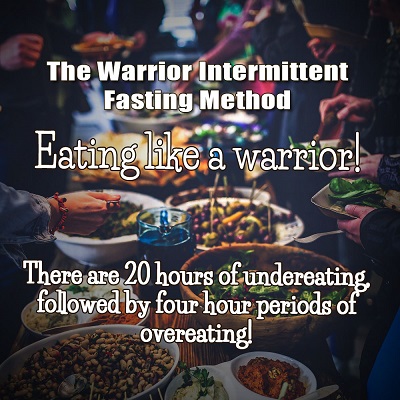 If you have been trying to lose weight, you have probably heard of intermittent fasting. It’s a diet that doesn’t tell you what to eat, it tells you when to eat. It has been linked to several health benefits, including improved metabolism, decreased insulin and blood sugar levels, better sleep, and improved mental health.
If you have been trying to lose weight, you have probably heard of intermittent fasting. It’s a diet that doesn’t tell you what to eat, it tells you when to eat. It has been linked to several health benefits, including improved metabolism, decreased insulin and blood sugar levels, better sleep, and improved mental health.
There are various ways to practice intermittent fasting, including the 16:8, 5:2, alternate-day fasting, and the eat-stop-eat method. Another popular method is the Warrior Method, which was developed in 2001 by former Israeli Special Forces member Ori Hofmekler. He took inspiration from the ancient practice of soldiers who ate little during the day and feasted at night.
The warrior method of intermittent fasting involves eating little during a 20 hour period and then during the remaining 4 hours, you eat as much as you like. You basically binge like a warrior!
Hofmekler pointed to our body’s need for the good kind of stress, achieved through reduced food intake, to promote the body’s response mechanisms to health risks. It’s just like when you are exercising; your body is subjected to physical stress, which in turn provides health benefits to the body.
One thing to note, though, is that Hofmekler’s warrior method is not strictly based on science, but primarily on his own beliefs and observations. There’s not much research to back this way of intermittent fasting, although people who have tried the warrior method have seen effective results in losing about 1 pound per week.
Because the warrior method involves long hours of undereating and 4 hours of eating as much as you want, many find it difficult to stick to and fit into their lifestyle. But if you want to check this out and see if it’s something that will work for you, here’s how to do the Warrior Method.
The warrior method is divided into three phases, which Hofmekler recommends to improve the body’s ability to burn fat and convert it to energy.
Phase 1: Detox
The first phase is the detox phase. For one week, only eat small amounts of raw vegetables and fruits, vegetable juices, dairy food like yogurt and cottage cheese, clear broth, and hard-boiled eggs during the 20 hours of what would normally be the fasting window.
Then in the 4-hour eating window, consume as much food as you want, however, make it healthy foods. It is recommended that you eat high protein foods from plant and animal sources, such as lean meat and nuts. Salads, rice, oats, and cooked vegetables can also be eaten.
Throughout the day, you should drink plenty of water. You can also take tea, coffee and sparkling water, and small amounts of milk. Avoid processed foods and beverages with artificial sweeteners as much as possible.
Phase 2: High Fat
The second week of the warrior method is focused on fat and protein intake. The recommended foods are the same as what’s in the first phase in the undereating period, but this time, you should avoid grains or starches altogether in the feast stage.
Phase 3: Concluding Fat Loss
The third phase of the program involves alternating high-carb and high-protein, low-carb days. Start with two days of eating foods that are high in carbs, followed by one or another two days of a high-protein, low-carb diet.
Eat the same foods as in phases 1 and 2 during the 20-hour ‘fasting’ window. Then during your eating period, high-carb foods that you can eat are oats, pasta, potatoes, barley or corn. On high-protein, low-carb days, you can add animal protein, nuts, and cooked vegetables.
When you finish the three-week cycle, Hofmekler recommends starting with phase one again. However, at this stage, many choose to forego the initial phases and just follow the 20-hour low-calorie food fasting and 4-hour protein-rich food eating windows.
The warrior method is recommended for those who have already tried other methods of intermittent fasting. Hofmekler also suggests taking multivitamins, probiotics, and amino acids while on this diet plan, as well as incorporating exercise to promote fat loss.
The Warrior Method Is Not For Everyone
If you have pre-existing health conditions or are prone to an eating disorder, you should not do this type of intermittent fasting. It can lead to side effects, some of which can be severe and worsen your conditions. These include fatigue, dizziness, anxiety, insomnia, fainting, hypoglycemia and extreme hunger.
Bottom line, the warrior method of intermittent fasting can be an effective method of losing weight, but it’s not for everyone. Others may also not thrive in doing this diet because it’s not that easy to follow. But if you have the desire to lose weight, eat healthily and responsibly, it is something anyone can try.






